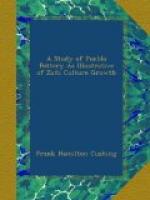The necks and apertures of these earliest forms of the water jar were made very small in proportion to their other dimensions, presumably on account of the necessity of often carrying them full of water over steep and rough mesa paths, coupled perhaps with the imitation of other forms. To render them as light as possible they were also made very thin. One of the consequences of all this was that when large they could not be stroked inside, as the shoulders or uttermost upper peripheries of the vessel could not be reached with the hand or scraper through the small openings. The effect of the pressure exerted in smoothing them on the outside, therefore, naturally caused the upper parts to sink down, generating the spheroidal shape of the jar. (see Fig. 531), one of the most beautiful types of the olla ever known to the Pueblos. At Zuni, wishing to have an ancient jar of this form which I had seen, reproduced, I showed a drawing of it to a woman expert in the manufacture of pottery. Without any instructions from me beyond a mere statement of my wishes, she proceeded at once to sprinkle the inside of a basket-bowl with sand, managing the clay in a way above described and continuing the vessel-shaping upward by spiral building. She did not at first make the shoulders low or sloping, but rounded or arched them upward and outward (see again Fig. 529). At this I remonstrated, but she gave no heed other than to ejaculate “wa na ni, ana!” which meant “just wait, will you!” When she had finished the rim, she easily caused the shoulders to sink, simply by stroking them—more where uneven than elsewhere—with a wet scraper of gourd (see Fig. 532, a) until she had exactly reproduced the form of the drawing. She then set the vessel aside in the basket. Within two days it shrank by drying at the rate of about one inch in twelve, leaving the basket far too large. (See Fig. 533.) It could hence be removed without the slightest difficulty.
[Illustration: FIG. 531.—Secondary form, in the mold.]
[Illustration: FIG. 532.—Scrapers
of gourd and earthenware for
smoothing
pottery.]
[Illustration: FIG. 533.—Finished
form of vessel in mold, showing
amount
of contraction in drying.]
The sand had prevented contact with the basket which would have caused the clay vessel to crack as the latter was very thin. This process exists in full force to-day with the Oraibes in the modeling of convex-bottomed vessels, and the Zunis thus make their large bowls and huge drum-jars.
Upon the bottoms of many jars of these forms, I have observed the impressions of the wicker bowls in which they had been molded—not entirely to be removed, it seems, by the most assiduous smoothing before burning; for, however smooth any exceptional specimen may appear, a squeeze in plaster will still reveal traces of these impressions.
[Illustration: FIG. 534.—Profile of olla, or modern water-jug.]




